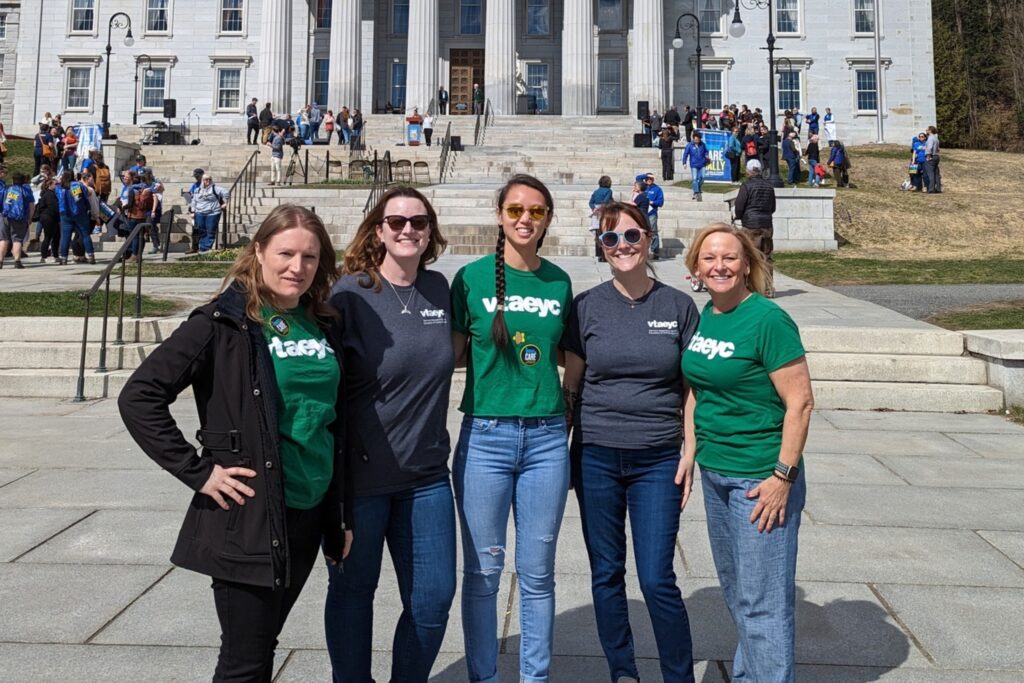Report recommends protecting and supporting: higher ed institutions’ early childhood education programs, student-attracting innovations, and resources to help students access key credentials and qualifications
Montpelier, VT — Vermont has made progress helping future early childhood educators access higher ed programs. At the same time, Act 76—passed in 2023 to expand the state’s child care capacity—has created new classrooms that need qualified educators. Yet many students don’t complete the credentials they need to lead these classrooms. A new report from the Vermont Association for the Education of Young Children (VTAEYC) shows where students are stopping or leaving programs and highlights ways the system can better support them so more can enter Vermont’s child care workforce.
The report, Higher Ed Pathways, Challenges, and Opportunities for Vermont’s Early Childhood Education Workforce, was researched and written by Heather Duhamel, M.Ed., VTAEYC’s Higher Education Outreach Coordinator and a faculty member at Vermont State University. Her findings show that Vermont’s higher ed programs in early childhood education are innovative, flexible, and well-aligned to help students succeed. But factors such as unclear program options, institutional instability, and federal policy changes can disrupt students’ paths.
The report identifies ways to strengthen Vermont’s higher ed pathways for early childhood educators:
-
Make it easy for students to start, pause, and return to their education at any stage.
-
Recruit students with clear, welcoming language that connects programs to career advancement.
-
Bring transfer agreements into view so students, advisors, and faculty know their options.
-
Protect bachelor’s and graduate programs from low enrollment to keep programs viable.
-
Help students complete credentials and connect education to better compensation and career growth.
The report revealed that many Vermont higher ed students stop after just two courses, a “six-credit cliff” that blocks progress toward key credentials like the 24-credit Child Care Certificate or an associate degree. “We’re seeing too many educators stop before earning meaningful credentials,” said Duhamel. “Vermont has strong entry points for students, but we need to make it easy for them to continue. Stable programs, affordable pathways, and clear opportunities to advance are essential if we want to have qualified educators stay and build lasting careers here.”
The report was researched before the 2025 federal reconciliation bill passed, restricting federal student loan access for “low-earning” majors. Early childhood education is widely recognized as among the lowest-earning majors in the country. In its conclusion, the report suggests that better compensation for Vermont early childhood educators, tied to their level of preparation, may preserve potential students’ access to higher ed and protect higher ed programs, and strengthen students’ interest in joining the child care workforce.
“This report gives us a clear picture of how our early childhood education workforce is engaging with Vermont’s higher education system, and where we need to act,” said Sharron Harrington, Executive Director of VTAEYC. “We need to support our higher education programs in preparing our early childhood educators. As Vermont invests in expanding families’ access to child care, we need a well-qualified, well-compensated workforce to teach those children.”
The full report, Higher Ed Pathways, Challenges, and Opportunities for Vermont’s Early Childhood Education Workforce, is available here.
About VTAEYC
The Vermont Association for the Education of Young Children (VTAEYC) is the statewide leader in early childhood professional development, policy, and advocacy. VTAEYC works to advance a strong, equitable early childhood system that ensures all Vermont children have the care and education they need to thrive.


